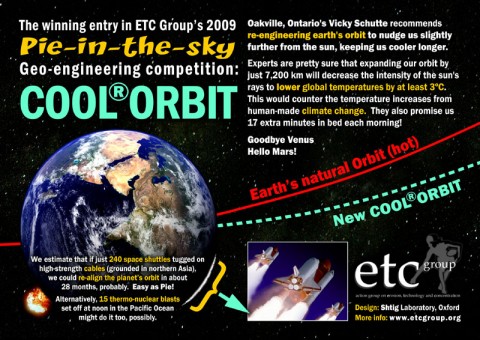Submitted by ETC Staff on

Vicky Schutte of Oakville, Ontario (Canada) took top honors today in ETC Group's international geo-engineering contest for her proposal to combat climate change by re-engineering the earth's orbit. Her idea is to nudge the planet further from the sun (and closer to Mars). In her entry, Schutte helpfully pointed out that expanding the earth's orbit would not only increase the distance between the earth and sun, thereby cooling the planet, but it would also take our birthdays longer to come around – climate salvation and fountain of youth all in one! The contest calling for geo-engineering proposals closed on April Fools' Day, netting 46 entries from 13 countries.
Geo-engineering refers to large-scale, intentional manipulations of the earth's land, sea and atmosphere to combat the effects of climate change. Schemes that would have been dismissed as science-fiction a few years ago are now gaining legitimacy in the view of some governments and scientific institutions. ETC's Pie-in-the-Sky contest aimed to highlight the absurdity – and danger – of carrying out planetary-scale experiments with unknown consequences.
ETC Group's Diana Bronson, in Anchorage, Alaska, attending the Indigenous Peoples Summit on Climate Change, noted that picking the Pie-in-the-Sky winner was no cakewalk. “There were lots of great entries, and we all had our favorites. I quite liked the idea of granting carbon offsets to anyone having their teeth whitened and willing to smile up at the sun, reflecting UV light away from the earth's surface. But since the beginning of February when we launched the contest, geo-engineering has gained real mainstream steam – in a report by the UK's House of Commons,[1] at an international science congress[2] and in an interview with the Obama administration's Science Adviser.[3] We decided to choose a proposal envisioning a massive re-engineering of the planet. In terms of scale and consequence, the winning proposal to modify the earth's orbit is not so different from real proposals to simulate volcanic eruptions or cover the earth's deserts in white plastic.”[4]
| Attachment | Size |
|---|---|
| 231.77 KB |
